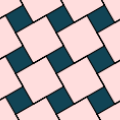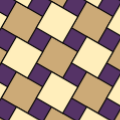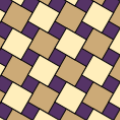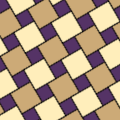File:Academ Pythagorean tiling and Pythagorean theorem.svg

Original file (SVG file, nominally 750 × 600 pixels, file size: 3 KB)
| This is a file from the Wikimedia Commons. Information from its description page there is shown below. Commons is a freely licensed media file repository. You can help. |
Summary
| DescriptionAcadem Pythagorean tiling and Pythagorean theorem.svg |
English: In order to remember some proofs of the Pythagorean theorem with jigsaw puzzles, we can keep in mind such tilings: see below examples of puzzle constructions associated to such tilings.
This classical tiling is created from a given right triangle: a complete covering of an Euclidean plane with an infinity of squares, the sizes of which are the leg lengths of the given triangle. On this drawing, every square element of the tiling has a slope equal to the ratio of sizes: a / b = tan θ. Thus a square pattern in dashed red is indefinitely repeated horizontally and vertically: see <pattern id="pg" in the source code. On this image, the square elements of the tiling have a ratio of sizes equal to tan 22.5° or its multiplicative inverse, mathematically written:
|
| Date | |
| Source | Own work |
| Author | Baelde |
| Other versions |
Pythagorean theorem A right triangle is given, from which a periodic tiling is created, from which puzzle pieces are constructed. On three previous images, the hypotenuses of copies of the given triangle are in dashed red. On left, a periodic square in dashed red takes another position relative to the tiling: its center is the one of a small tile. And one of the puzzle pieces is square, its size is the one of a small tile. The four other puzzle pieces have stripes. They can form together a large tile, and they are congruent, because of a rotation a quarter turn around the center of any tile that leaves unchanged the tiling and the grid in dashed red. Therefore the area of a large tile equals four times the area of a striped piece. In case where the initial triangle is isosceles, the midpoint of any segment in dashed red is a common vertex of four tiles with equal sizes: a = b, and each striped piece is still a quarter of a tile, it is an isosceles triangle. Whatever the shape of the initial triangle, the two assemblages of the five puzzle pieces have equal areas: Periodic tilings by squares SVG images coded with a pattern element |
| SVG development InfoField | This /Baelde was created with a text editor. |
Licensing
- You are free:
- to share – to copy, distribute and transmit the work
- to remix – to adapt the work
- Under the following conditions:
- attribution – You must give appropriate credit, provide a link to the license, and indicate if changes were made. You may do so in any reasonable manner, but not in any way that suggests the licensor endorses you or your use.
- share alike – If you remix, transform, or build upon the material, you must distribute your contributions under the same or compatible license as the original.

|
Permission is granted to copy, distribute and/or modify this document under the terms of the GNU Free Documentation License, Version 1.2 or any later version published by the Free Software Foundation; with no Invariant Sections, no Front-Cover Texts, and no Back-Cover Texts. A copy of the license is included in the section entitled GNU Free Documentation License.http://www.gnu.org/copyleft/fdl.htmlGFDLGNU Free Documentation Licensetruetrue |
Captions
Items portrayed in this file
depicts
19 October 2012
image/svg+xml
44a329b91de4393c08fdef7bb9b050f4cb4239f7
3,577 byte
600 pixel
750 pixel
File history
Click on a date/time to view the file as it appeared at that time.
| Date/Time | Thumbnail | Dimensions | User | Comment | |
|---|---|---|---|---|---|
| current | 04:32, 19 October 2012 |  | 750 × 600 (3 KB) | Baelde | {{Information |Description ={{en|1=This classical tiling is created from a given right triangle: a complete covering of an Euclidean plane with an infinity of squares, the&nb... |
File usage
The following page uses this file:
Metadata
This file contains additional information, probably added from the digital camera or scanner used to create or digitize it.
If the file has been modified from its original state, some details may not fully reflect the modified file.
| Width | 750 |
|---|---|
| Height | 600 |






















